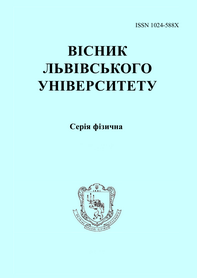DOI: https://doi.org/10.30970/vph.58.2021.85
Influence of ferroelastoelectric phase transition on the temperature evolution of the optical absorption edge of an ammonium dihydrate tetrachlorocuprate crystal
V. Kapustianyk, S. Semak, Yu. Chornii

| Visnyk of the Lviv University. Series Physics
58 (2021) ñ. 85-97
DOI: https://doi.org/10.30970/vph.58.2021.85 Influence of ferroelastoelectric phase transition on the temperature evolution of the optical absorption edge of an ammonium dihydrate tetrachlorocuprate crystalV. Kapustianyk, S. Semak, Yu. Chornii |  |
On the basis of study of the temperature evolution of the optical absorption edge of (NH 4 ) 2 CuCl 4 \cdot2H 2O crystal, the ferroelastoelectric phase transition at the temperature \textit{T} c = 200,5 K was confirmed, as evidenced by the corresponding anomalies in the temperature dependences of the Urbach’s rule parameters, in particular of \sigma and Å’. Performed spectral investigations confirmed a strong influence of the electron-phonon interaction on the position and shape of the absorption edge in (NH 4 ) 2 CuCl 4 \cdot2H 2O crystals. As a result, for the phase lying above \textit{T} c and the temperature region below 100 K the low energy tail of the edge band follows the empirical Urbach’s rule. Nonfulfillment of the Urbach’s rule in the temperature range of 100 \div 200,5 Ê would be associated with light scattering on the ferroelastoelectric domains, the size of which in this temperature range is commensurate with the wavelength of light. The values of \sigma0 were found to be larger in comparison with those for the case of the localised exciton edge band observed in the related materials with an alkylammonium cation from A 2 BX 4 family. This testifies to a smaller strength of the EPI in (NH 4 ) 2 CuCl 4 \cdot2H 2O crystals that is characteristic of the edge bands of a charge transfer type. The calculated effective energy of phonons participating in formation of the absorption edge in the FEE phase precisely coincides with the frequency of the binding vibration \delta (Cl(II)-Cu-OH 2 ) within metal-halogen-hydrate complex (242 cm -1 ) observed in the investigations of the Raman spectra of (NH 4 ) 2 CuCl 4 \cdot2H 2O crystals. This looks natural since the charge transfer band originates from the electron transitions between the central ion and the ligand Cl - ion. Very similar situation was found to be in the majority of phases in the related materials manifesting the charge transfer band. One can also suggest that in the initial phase the rocking vibration of the crystallization water are most of all responsible for the broadening of the absorption edge.